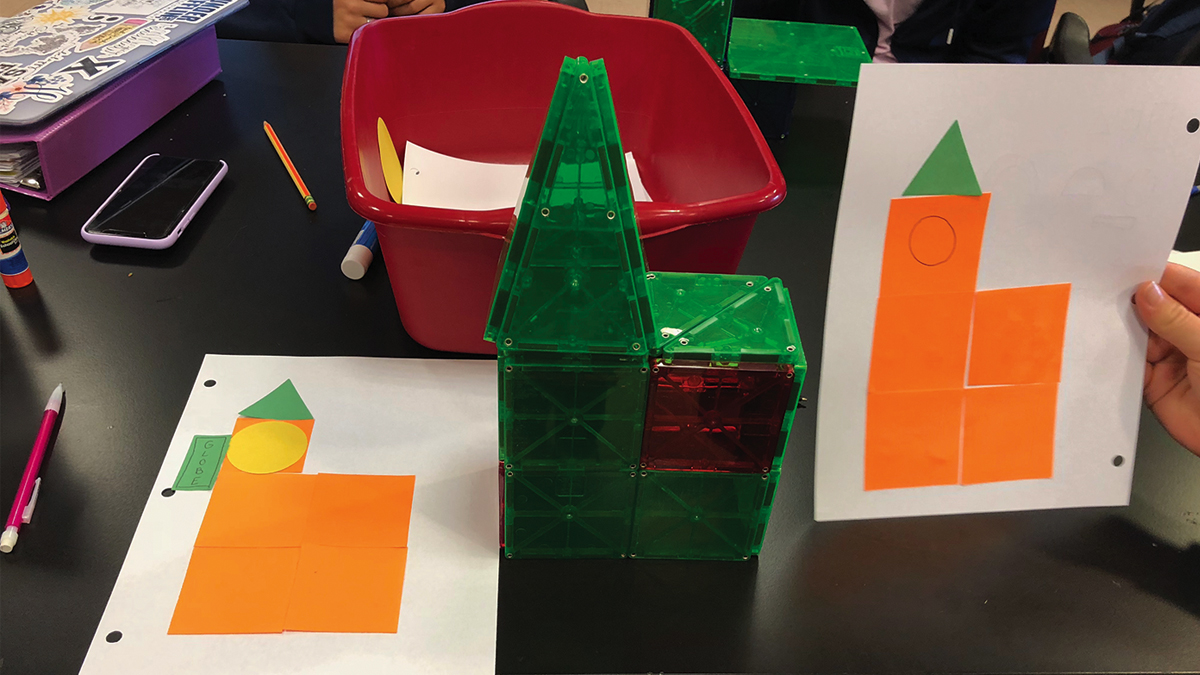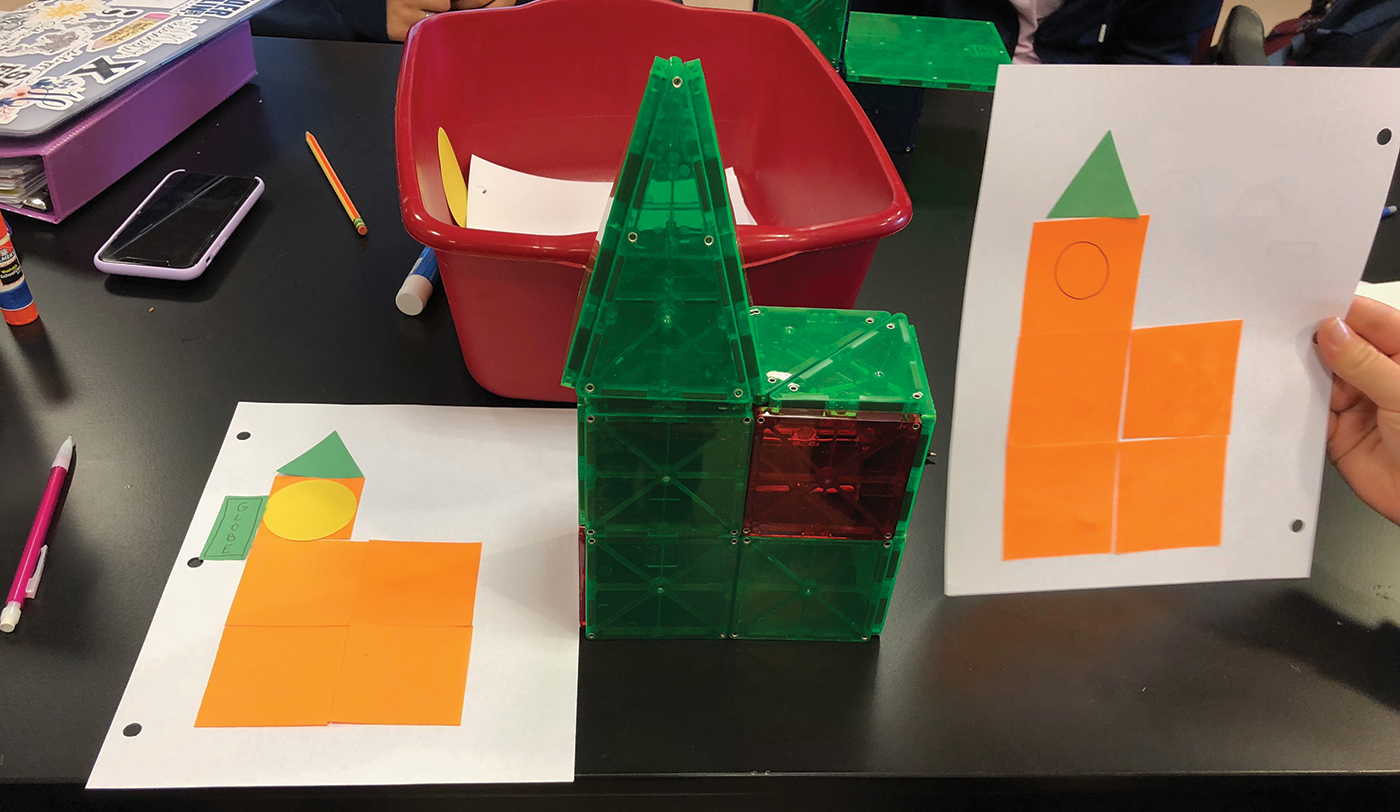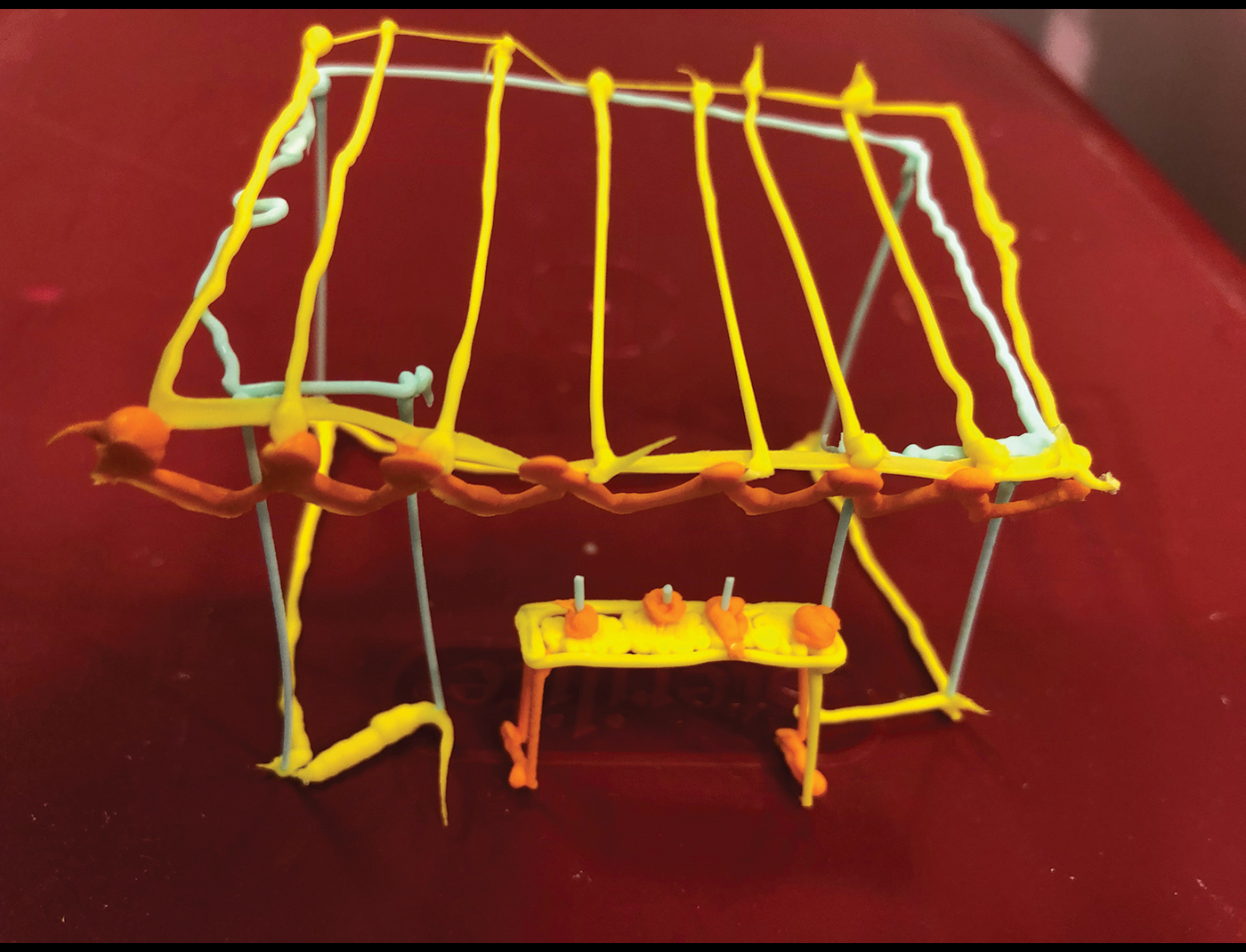Teaching Teachers
The Geometry of Buildings
A module for preservice teachers makes STEAM more accessible
Science and Children—February 2020 (Volume 57, Issue 6)
By Lauren Angelone

“Before completing this module, I had assumed that STEAM education was much more high-tech than it actually is. With this assumption in mind, I thought it would be difficult to bring STEAM into my Early Childhood Classroom. However, I now see how any STEAM lesson can be adapted to integrate technology for any age of learners. I now value STEAM more than I initially did.” – Preservice Teacher
This was a common sentiment from preservice teachers in a methods course after participating in a blended STEAM module designed to cover kindergarten standards across subject areas. In the module described here, preservice teachers worked in groups to complete a quality example of a STEAM module for early learners. The module was created in a learning management system, an online classroom that supports the posting of assignments, to give preservice teachers flexibility in their pacing and as a referent for STEAM lessons that they would design in a future field experience.
STEAM in Early Childhood Education
STEM (Science, Technology, Engineering, and Mathematics) has been at the center of a national conversation around the necessity to strengthen our STEM workforce starting with STEM education in K–12 schools. The Next Generation Science Standards (NGSS Lead States 2013) incorporate a prominent engineering component in both disciplinary core ideas and practices. In 2015, the White House launched the Innovate to Educate partnership focused on STEM education and diversifying the STEM talent pool. These efforts have led to the further development of STEM curriculum for K–12 students.
STEAM, an iteration of STEM that incorporates the arts, is becoming more prevalent in early childhood education settings and serves as an aesthetic context that naturally extends engineering and technology experiences (Wynn and Harris 2012). The past decade has seen a significant growth in makerspaces and STEAM labs making their way to elementary schools. Makerspaces and STEAM labs are areas with both physical and technological resources for students to create. These spaces provide environments for teachers to integrate Science, Technology, Engineering, Art, and Mathematics as a way for students to use higher level thinking to make complex meaning in traditionally discrete subjects.
Early childhood education majors at Xavier University in Cincinnati, Ohio, take a Math/Science methods block during their junior year, alongside an Integrated Art course. The Math/Science methods block is designed to prepare candidates to teach science and mathematics to children age 3 to grade 3. Likewise, the Integrated Art course is designed to prepare candidates to integrate the arts throughout the curriculum at this age level. These courses provided a unique opportunity to incorporate STEAM education in a meaningful way that aligned with course outcomes and provided opportunities for students to understand and apply best practices in STEAM education. As such, the STEAM module presented in this article, The Geometry of Buildings, was designed to cover kindergarten standards but also to provide preservice early childhood education majors a high-quality experience with STEAM education.
Module Development
The Geometry of Buildings was developed using several constructivist and constructionist strategies considered best practice in science, math, and engineering education. The learning cycle (Bybee et al. 2006) is a constructivist instructional model used in both math and science in which students first gain experience with concepts before naming them and then extending them further. Project-based learning (Krajcik and Shin 2014) is another constructionist, student-centered approach targeting significant learning goals by using a project to promote learning. Constructionism furthers constructivist ideas that students build their own understanding by adding that the creation or construction of real physical materials plays an important role in this process. The final approach used within the module was the engineering design process (EIE 2018), which follows a similar constructionist approach to project-based learning and supports students in constructing knowledge through an engineering design process. Below we share a summary of the module.
The Module
The module was developed in a learning management system and organized to allow preservice teachers to both reflect and engage with content and design process as their future students might. Within the learning management system, the module included three reflections and a section for each phase of the learning cycle. All activities were completed in class with all materials in the learning management system as a guide. Preservice teachers started with a reflection, then completed the Engage, Explore, and Explain portions as a whole group led by the professor, then completed a second reflection. Next, preservice teachers completed the Extend and Evaluate sections at their own pace and finished with a final reflection on the use of STEAM education. The module took place over two three-hour blocked class periods.
The module began with a discussion board prompting preservice teachers to reflect on how they currently define STEAM and to assess the value of STEAM teaching. Many preservice teachers were optimistic about the idea of STEAM but concerned with the practicality of teaching it to young learners. The following is a sample student response from the initial reflection:
“STEAM goes beyond STEM to engage different types of learners and allowing for students to work together to achieve an end product. This is valuable in early childhood education because it allows all students to succeed and find excitement in learning. I think it offers students a unique way to learn and apply their learning to real world scenarios. A critique would be that in an early childhood setting, giving students the independence to work on a STEAM project may be hard when they are so young.” — Preservice Teacher
Engage: 30 Minutes
The module began with the professor introducing the term architecture and holding a class discussion on the importance of buildings in their lives (Figure 1). Architecture is a focus as it is a unique subject that incorporates art and engineering. The professor told preservice teachers that buildings are made of shapes and that they would be looking for shapes in a book. Iggy Peck, Architect (Beaty and Roberts 2007), a book about a boy who loves architecture, is read aloud as preservice teachers recorded shapes they observed on a piece of paper. Preservice teachers shared their list of shapes and the professor recorded their findings on the interactive whiteboard (see Resources).
The professor introduced a 360-degree video of buildings in our city (see Internet Resources). Though students are working in groups of about four, ideally, students should view the videos individually on iPads. If a class set of iPads is not available, groups could share one device as there are multiple viewing options (laptops, tablets, 3D viewers). Preservice teachers were able to use their smartphones and the professor provided Google Cardboard (see Internet Resources) as a 3D viewing option.
The professor reminded preservice teachers that architects create buildings using shapes and that there are many buildings around Cincinnati where you can see the shapes in buildings. Preservice teachers were then asked to identify a building they would like to model using shapes that were glued down using pre-cut paper shapes. They then shared their buildings with the class and described the shapes that they used to create it. The professor modeled observation of student ideas, noting the language used to describe the shapes and position of shapes in relation to one another.
The professor then presented a square Magna-Tile and compared it to a building that a preservice teacher had created on paper. The professor asked if this is what a building looks like in real life. “Can anyone walk into this building? How could we make the building have space inside for people?” The professor listened to ideas and then provided Magna-Tiles and asked preservice teachers to try to build their building with space inside. Figure 2 shows an example of a preservice teacher’s two-dimensional model and subsequent three-dimensional model (referred to as “flat” or “solid” at this age level, though preservice teachers should be able to use more sophisticated terminology).

Explain: 30 Minutes
Preservice teachers shared their models made with Magna-Tiles, indicating the “flat” shapes used to create the “solid” shapes in a first attempt to explain the new concept. The professor used this conversation as a time to review the definitions of basic two-dimensional shapes that were identified and introduce students to three-dimensional shapes by demonstrating to students the idea that three-dimensional shapes are created from two-dimensional shapes by creating of a cube with six Magna-Tiles. The professor stated, “an important part about buildings, is that people use them for shelter, so they need four walls and a roof. So, using more than one ‘flat’ shape, a ‘solid’ shape can be created with space inside for people.” An instructional video (see Internet Resources) with new three-dimensional shapes is shown to the whole group and preservice teachers are asked to think if they have seen buildings with these new shapes. The teachers then completed an exit slip, a short formative assessment, in which they were asked to give one example of a “flat” (two-dimensional) shape and one example of a “solid” (three-dimensional) shape.
Following the “Explain” portion of the learning cycle, preservice teachers were asked to reflect upon how their ideas about STEAM were evolving based on their experience with a STEAM module. Preservice teachers shared that they were beginning to feel like STEAM was less intimidating and more integrated into the curriculum than previously thought.
“STEAM is much more basic than I initially thought. The STEAM model [sic] we completed as ‘Kindergartners’ was very easy and fun. Additionally, I could clearly see the various disciplines and how they intertwine. Previously, I assumed that STEAM education was a supplement to daily classroom instruction. I did not realize how related it was to the Standards that the children were already expected to learn. However, seeing how well the STEAM activity about shapes fit in with kindergarten Math and Science standards, I have a greater appreciation for STEAM. I now see it as a way to enhance lessons rather than supplement them.” — Preservice Teacher
Extend/Engineer: Three Hours for Multiple Iterations
The professor explained to preservice teachers that they would now get the chance to create a building of their own using the design process. Preservice teachers were tasked with designing a building that they thought they need in their own neighborhood. To elicit ideas, the professor read aloud If I Built a House (Van 2013), which gave over-the-top ideas of possibilities for architecture and Dreaming Up: A Celebration of Building (Hale 2015), which provided a multicultural look at architecture around the world. While preservice teachers listened to the stories, they drew ideas. The professor conducted a classroom discussion around ideas, keeping the focus on the needs of people in their neighborhoods. Preservice teachers drew plans for their buildings, further modeled their ideas in three dimensions with Magna-Tiles, and iterated as necessary.
When preservice teachers were satisfied with their models, they created a more permanent three-dimensional model using the 3Doodler (Figure 3). A 3Doodler is a pen that draws in 3D and is often used as a precursor for students to understand 3D printing. If a 3Doodler is not available, students could create their models with clay or construction paper. Preservice teachers were encouraged to add aesthetic details to make their buildings more realistic. The focus on architecture is the art and engineering component of the STEAM module. Not only are students designing for a specific need in their communities, but they are considering the artistic design of constructed environments as required in the National Art Standards.

Evaluate: One Hour
As an assessment, preservice teachers used their 3Doodler model and, in groups, created a short video on Flipgrid (see Internet Resources) in which they showcased their models by describing all shapes present, their relative positions, and compared it to another group’s model. Flipgrid is a tool that allows students to easily record short videos. Flipgrid is especially helpful to differentiate for students who need to explain their ideas verbally, though students could also simply share their models verbally with the class if little technology is available.
Conclusion
“After completing this module, I am even more convinced of STEAM education’s value. The processes used in STEAM lessons can help children develop their problem-solving skills, and the Art aspect really helps with designing and working out ideas.”
—Preservice Teacher
To wrap up the module, preservice teachers completed a final reflection in a discussion board in the learning management system. As a result of participating in this STEAM module, preservice teachers at Xavier identified several outcomes.
Preservice teachers reported that, after participating in a STEAM module at the kindergarten level, they felt less intimidated by the idea of implementing STEAM into their future classrooms. Through engagement with the module, they found STEAM education to be accessible to kindergarteners.
Preservice teachers also reported that they valued STEAM education even more after participating in the module. The value of STEAM for these teachers was in the fully student-centered approach that engaged students in real-world contexts while still covering standards.
Preservice teachers previously thought of STEAM education as an add-on to the curriculum to be completed in after-school programs or in specials classes. After participating in this STEAM module, preservice teachers reported that they could use STEAM in their own classroom to teach integrated content.
INTERNET RESOURCES
360 degree video
https://vimeo.com/286603381/ f72f9fa59d
3D shapes video
https://youtu.be/awdthrGmZ4U
3Doodler Start
http://3doodlerstart.com/ ($49; safe for ages 6+)
Flipgrid
https://flipgrid.com/
Google Cardboard
https://vr.google.com/cardboard/
5E Preservice Science Education STEM Teacher Preparation Elementary


